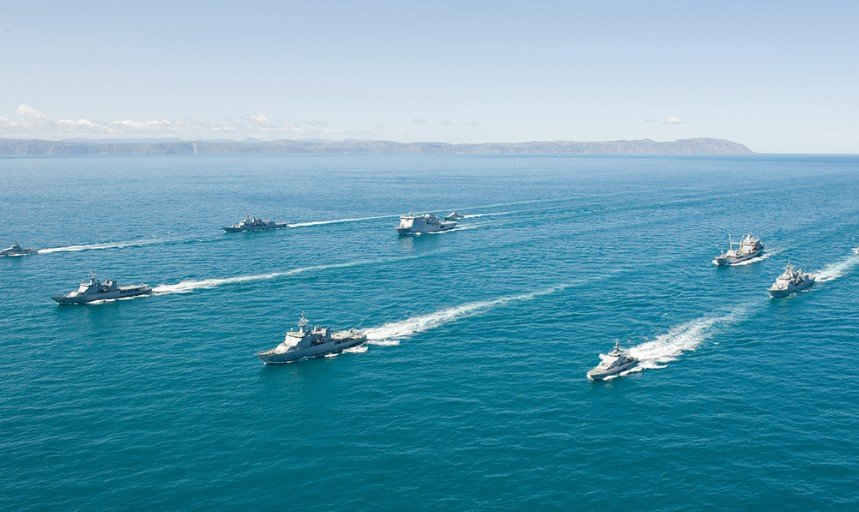A major naval exercise called Red Wave 8 has kicked off in Saudi Arabia, drawing forces from Egypt, Jordan, Sudan, Yemen, Djibouti, and the host nation. This drill aims to boost security in the Red Sea, but it has sparked fresh concerns in landlocked Ethiopia about being left out of key maritime alliances.
The exercise started on November 11, 2025, and focuses on joint operations to tackle threats like smuggling and mines in this vital trade route. Ethiopia sees the move as a push by Egypt and Saudi Arabia to tighten control over the waterway, potentially harming its economic interests.
What is Red Wave 8 and Why Now?
Red Wave 8 is a multinational naval drill hosted by Saudi Arabia at the King Faisal Naval Base. It brings together forces from six countries to practice coordinated responses to maritime risks.

This year’s exercise comes amid rising tensions in the region. Recent Houthi attacks on shipping have disrupted global trade, making secure routes a top priority for nations along the Red Sea. The drill includes live simulations, classroom sessions, and planning for real-world scenarios like countering unconventional threats.
Participating navies are sharing tactics to improve how they work together. Observers note that such exercises help build trust and quicken response times in crises. With global powers like the US, China, and others maintaining bases nearby, the Red Sea remains a hotspot for international rivalries.
The timing aligns with ongoing worries about stability. Just last month, reports highlighted increased military movements in the area, tied to broader conflicts in Yemen and beyond.
Key Players in the Drill
Egypt and Saudi Arabia lead the pack as the main organizers. They founded the Red Sea alliance back in 2019 to safeguard this crucial corridor that handles about 10 percent of world trade.
Other participants include Jordan, Sudan, Yemen, and Djibouti. Each brings unique strengths, from coastal patrols to air support.
Here is a quick look at the involved nations and their contributions:
| Country | Role in Drill | Key Asset |
|---|---|---|
| Saudi Arabia | Host and lead coordinator | Advanced naval fleet |
| Egypt | Joint planning and simulations | Experienced marine forces |
| Jordan | Border security tactics | Special operations units |
| Sudan | Anti-smuggling operations | Coastal monitoring |
| Yemen | Threat response training | Local waterway knowledge |
| Djibouti | Logistics and base support | Strategic port access |
This setup shows a united front among Red Sea coastal states. Yemen’s involvement is notable, given its internal conflicts, but it underscores the shared goal of stability.
Ethiopia’s Growing Concerns
Ethiopia, without direct access to the sea, feels sidelined by the alliance. Officials in Addis Ababa worry that stronger ties among these nations could block their trade routes and economic growth.
A key figure in Ethiopia’s foreign affairs committee recently told media that Egypt aims to isolate the country. This stems from long-standing disputes, including the Grand Ethiopian Renaissance Dam, which has strained relations with Egypt over Nile water shares.
Ethiopia has pushed for sea access through deals with neighbors like Somaliland. But the Red Wave 8 drill highlights how coastal powers are closing ranks, leaving Ethiopia to seek diplomatic ways to protect its interests.
Analysts say Ethiopia might ramp up talks with other allies, such as the UAE or Turkey, to counterbalance the shift. The concern is real, as any Red Sea instability could raise shipping costs for Ethiopian imports and exports.
Recent events add fuel to the fire. In 2025, Ethiopia signed a memorandum with Somaliland for port access, drawing criticism from Somalia and Egypt. This naval exercise seems like a response, signaling that non-coastal states won’t get a say in Red Sea governance.
Broader Impact on Regional Security
The Red Sea is more than a trade lane; it’s a zone of competing influences. Powers like Iran, Turkey, and Gulf states vie for sway, while global players maintain military outposts.
This drill could deter threats like piracy and militancy. For instance, Houthi rebels in Yemen have targeted ships, prompting international responses. By aligning forces, participants aim to prevent such disruptions.
On the flip side, excluding countries like Ethiopia and Eritrea might heighten rivalries. Eritrea, another non-participant, has its own Red Sea ports but stays out of the alliance.
Experts predict this could lead to new partnerships or tensions. With climate change and trade growth, securing the Red Sea will remain critical for years.
What This Means for Global Trade
Global commerce relies on the Red Sea for oil, goods, and containers moving through the Suez Canal. Any alliance shift could affect prices and routes.
Here are some potential outcomes:
- Stronger security might lower insurance costs for ships.
- Tensions could force rerouting around Africa, adding time and fuel expenses.
- Increased cooperation may attract more investment in ports and infrastructure.
- Landlocked nations like Ethiopia might face higher trade barriers if alliances tighten.
Businesses worldwide are watching closely. In 2025, shipping firms have already adjusted paths due to regional risks, and this drill could either calm or stir the waters further.
If you found this article helpful, share it with others interested in global affairs and drop a comment below on what you think Ethiopia’s next move might be.
